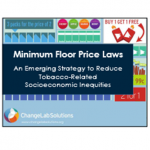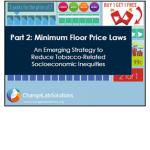Minimum Floor Price Laws
Setting minimum prices to reduce tobacco use
One of the most effective ways to reduce tobacco use is to increase the prices of tobacco products. An effective strategy for increasing tobacco prices is instituting a minimum floor price law (MFPL) in a specific locale. An MFPL sets a price below which the product cannot be sold.
Tobacco companies often reduce prices or offer coupons in response to other price-related tobacco control policies, like excise taxes. By setting a floor price, MFPLs can offset industry price manipulation, especially if a discount ban is included in the policy. When accompanied by strong smoking cessation resources, MFPLs may reduce racial, socioeconomic, or other disparities in tobacco use and associated health outcomes.
This fact sheet explains the public health and health equity rationales for MFPLs, offers examples of jurisdictions that have adopted an MFPL, and outlines some considerations for jurisdictions considering adoption of an MFPL.
The Gillings School of Global Public Health at the University of North Carolina collaborated with ChangeLab Solutions to create this resource for tobacco control advocates, public health professionals, and policymakers who are interested in implementing an MFPL to improve health and equity. We thank the California Tobacco Control Program for their support in developing this fact sheet.




